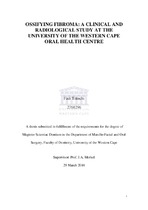| dc.description.abstract | Ossifying fibroma (OF) is the most frequent of the three fibro-osseous lesions of the jaws. It occurs mostly in patients between the age of 20 and 40 years. Females are more commonly affected than males. Clinically, OF usually presents as a painless expansive intra-bony mass. Swelling and pain may be present in some cases while some lesions are discovered incidentally. Radiographically, OF is usually well-defined and unilocular or multilocular. Early lesions present as well-defined radiolucency that are small in size. Over time, the lesions tend to enlarge in size and become mixed radiolucent-radiopaque and finally become completely radiopaque. The aim of this study was to determine the clinical and radiological features of ossifying fibroma presenting at the Departments of Maxillo-Facial and Oral Surgery and Diagnostics and Radiology, University of the Western Cape Oral Health Centre as well as to assess its management and recurrence patterns. A retrospective case series analysis was performed of all histopathologically diagnosed ossifying fibroma cases available at the Departments of Maxillo-Facial and Oral Surgery and Diagnostics and Radiology at the Faculty of Dentistry, University of the Western Cape from 1976-2014. Patient's age, gender and ethnicity were recorded. The clinical presentation of the lesion as well as the history was analyzed. Radiographic features including density, size, shape, location, locularity and its effect on adjacent structures was noted. Management
of each case and follow-up was also documented. A total 61 cases were included in the study. The majority of patients were females (63.9%) and below 40 years of age (73.9%). Few cases were symptomatic (29.5%) with an average period 22 months from first symptoms to presentation. The mandibular posterior region was most affected (55.5%) while larger lesions occurred more frequently in younger patients. Majority of lesions were radiopaque (49.2%) and had well-defined margins (93.6%). Most cases were managed by surgical curettage (68.2%).
Following an average follow-up period of 20 months only one case recurred (recurrence rate =6.7%). In conclusion, the majority of the clinical and radiographic findings of ossifying fibroma were similar in South African patients as those of other populations. Differences include that the lesions in this population were more radio-opaque and larger in size than in the reported literature. Surgical curettage is an acceptable management protocol with low rate of recurrence. | en_US |

